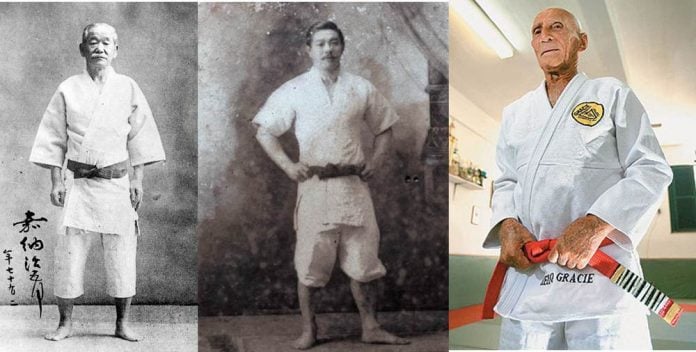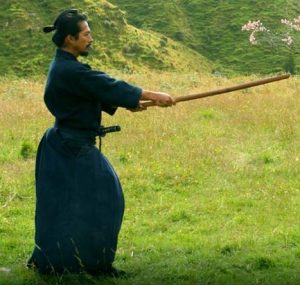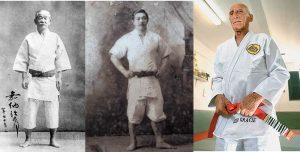
When people think of BJJ they automatically think about men and women in GIs wrestling on the ground. Although BJJ training gear today transcends tradition, the Gi still holds the primate as the most used apparel. As with the belt system and certain other formalities like saying Oss, the Jiu-Jitsu Gi has deep traditional roots.
The BJJ Gi is used for much more than just a style. It can be a great offensive weapon, a key tool for defending, and plays a role in hygiene, amongst other things. Today, the Gi is made up of two main parts, pants and a jacket plus the belt.
Japanese Roots of Jiu-Jitsu Gi
The kimono originates from feudal Japan, where it was the traditional outfit of the Japanese samurai. The samurai wore different colored kimonos back then, each color representing a clan. The kimono had an undergarment role, worn under the armor which meant strikes were hardly efficient. That’s where grappling came into the picture and spurred the growth of arts like Judo and Jiu-Jitsu. Imagine a Karate uniform of today, only baggier. The original kimono consisted of an additional third part compared to the modern Gi. The samurai also wore Hakamas, or wide pants today worn by Aikido Black Belts.
As Judo developed, in the early 1900s the traditional samurai kimono was deemed impractical for the art. Dr. Jigoro Kano decided to change the usual design and came up with a sturdier version. The result was a tighter, shorter uniform that was sewn together differently than the traditional model. That’s how the Jiu-Jitsu Gi is known today, first came to be.
Of course, they migrated along with Judo to Brazil, where it was instrumental in the development of BJJ. Even the original premise of the Gi being an equalizer in Judo, became a staple of Helio Gracie’s philosophy.
The Brazilian Jiu-Jitsu Gi
When Dr. Kano modified the kimono, he moved away from the colored versions specific to the samurai. After the new design modifications, all practitioners wore white GIs. In the early days of BJJ, students got a GI before training and had to return it for washing afterward. Everyone wearing the same white uniform helped lower the impact of social differences in the gym. This is when the Gi went through a second modification.
The Judo GI, although great for throwing and sleeve grabs, was not exactly the best for Jiu Jitsu grips. In order to optimize its ground fighting potential, the Gi became even tighter and narrower, with a shorter jacket and sleeves.
Evolution Of The Modern Jiu Jitsu Gi
The first colored Gis emerged during the ’70s, courtesy of Reylson Gracie, Carlos’ son. Along with color came the third modification, now returning some length in the sleeves due to competition requirements.
About a decade later, patches followed in the footsteps of colors, as sponsors became prevalent in the sport. With the growth of the competition scene, came an increase in financial demands for aspiring athletes. This led to advertisements of everything, from local restaurants to barber shops displayed in the form of Gi patches. This practice became even more prominent during the 90s. The growth of Jiu-Jitsu and its worldwide spread brought about the emergence of various Gi brands. In the 90’s it was down to a couple of brands, which worked well for both brands and sponsored athletes. BJJ Gi manufacturing soon turned into a profitable business venture, leading to a huge increase in brands.
Today, a regular Brazilian Jiu-Jitsu Gi is mostly made up of a jacket and pants, in white, blue, or black color and with one or more brand patches attached. Some people do tend to go heavy on the patches and others experiment with Camo or pink-colored GIs. However, only the “regular” version described above is allowed in official competition events. In terms of weave, today’s BJJ GIs come in single, double, pearl, gold, and others, with rip-stop pants technology. Along with all the brands and weave and material options, come different prices for the GIs.
Moving away from the BJJ Gi
With the UFC, and later PRIDE, popularizing BJJ through MMA, fighters slowly started moving away from the GI. While it was a huge advantage originally, with unified MMA rules into play, fighters ended up battling only in shorts. This meant that Jiu-Jitsu had to be modified to better fit MMA needs and techniques started changing.
Competitions like the ADCC gave an even larger platform to people looking to compete without the GI, resulting in the No-Gi discipline. During the early days of BJJ in Brazil, people only trained without jackets on extremely hot and humid days. Today, No-Gi is a recognized and integral part of BJJ with its own original apparel.
Despite most schools favoring either Gi or No-Gi in modern times, during the last decade, it has become usual practice for schools to host both types of classes. Some, like No-GI’s most vocal proponent Eddie Bravo, even like to train/compete in hybrid apparel. Remember Bravo’s match with Royler at Metamoris? He came out with a top rashguard and GI pants on, able to grapple in both worlds.
Related Articles:
The Difference Between Japanese (traditional) Jiu-Jitsu And BJJ
https://bjj-world.com/wearing-a-rashguard-under-the-gi/
Cool, Funny, Ridicolous and Cheap BJJ Gis for Everyone’s Pocket


![Darce Choke Encyclopedia – Origins, Mechanics and Variations [2025] BJJ, choke, Brabo, BJJ Darce Choke, D'arce Choke, Darce BJJ Choke](https://bjj-world.com/wp-content/uploads/2017/11/JungPoirierLeeYahoo-218x150.jpg)












![Leg Locks Finishes Helena Crevar DVD Review [2025] Leg Locks Finishes Helena Crevar DVD Review](https://bjj-world.com/wp-content/uploads/2025/04/leg-locks-finishes-helena-crevar-dvd-review-218x150.png)


![Leg Entanglement System: X Lock Owen Jones DVD Review [2025] Leg Entanglement System: X Lock Owen Jones DVD Review](https://bjj-world.com/wp-content/uploads/2025/04/leg-entanglement-system-x-lock-owen-jones-dvd-review-218x150.png)
![[WATCH] John Wick Invitational 2 Delivers Viral Suit-Jitsu Spectacle [WATCH] John Wick Invitational 2 Delivers Viral Suit-Jitsu Spectacle](https://bjj-world.com/wp-content/uploads/2025/04/john-wick-invitational-2-suit-jitsu-spectacle-218x150.png)

![Slicin’ Calves Mikey Musumeci DVD Review [2025] Slicin' Calves Mikey Musumeci DVD Review](https://bjj-world.com/wp-content/uploads/2025/04/slicin-calves-mikey-musumeci-dvd-review-100x70.png)







![No-Gi Open Guard K-Guard Lachlan Giles DVD Review [2024] No-Gi Open Guard K-Guard Lachlan Giles DVD Review](https://bjj-world.com/wp-content/uploads/2024/12/no-gi-open-guard-k-guard-lachlan-giles-dvd-review-100x70.png)


![Slip N Slide Into Victory Julián Espinosa DVD Review [2025] Slip N Slide Into Victory Julián Espinosa DVD Review](https://bjj-world.com/wp-content/uploads/2025/01/slip-n-slide-into-victory-julian-espinosa-dvd-review-100x70.png)

![Reverse Arm Bar System Andrew Kerfoot DVD Review [2024] Reverse Arm Bar System Andrew Kerfoot DVD Review](https://bjj-world.com/wp-content/uploads/2024/10/reverse-arm-bar-system-andrew-kerfoot-dvd-review-100x70.png)
![Jeff Glover Deep Half Revolution DVD Bundle Review [2024] Jeff Glover Deep Half Revolution DVD Bundle Review](https://bjj-world.com/wp-content/uploads/2024/10/jeff-glover-deep-half-revolution-dvd-bundle-review-100x70.png)







![The Bear Trap Nicolas Renier DVD Review [2025] The Bear Trap Nicolas Renier DVD Review](https://bjj-world.com/wp-content/uploads/2025/01/the-bear-trap-nicolas-renier-dvd-review-100x70.png)
![Eoghan O’Flanagan Bundle Down Right Sloppy Jiu-Jitsu Review [2024] Eoghan O'Flanagan Bundle Down Right Sloppy Jiu-Jitsu Review 2024](https://bjj-world.com/wp-content/uploads/2024/09/down-right-sloppy-jiu-jitsu-eoghan-oflanagan-bundle-100x70.png)
![Roger Gracie Closed Guard System DVD Review [2025] Roger Gracie Closed Guard System DVD Review](https://bjj-world.com/wp-content/uploads/2025/01/roger-gracie-closed-guard-system-dvd-review-100x70.png)

![Closed Guard Reintroduced Adam Wardzinski DVD Review [2025] Closed Guard Reintroduced Adam Wardzinski DVD Review](https://bjj-world.com/wp-content/uploads/2025/01/closed-guard-reintroduced-adam-wardzinski-dvd-review-100x70.png)